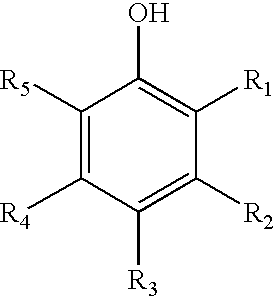Combinations of resin compositions and methods of use thereof
a technology of resin compositions and components, applied in the field of resin compositions, can solve the problems of reduced productivity, mechanical and electrical failure of electronic devices, and significant mechanical stress experienced by solder bumps in the chip construction, and achieve the effect of enhancing the fluxing of solder balls and preventing misalignmen
- Summary
- Abstract
- Description
- Claims
- Application Information
AI Technical Summary
Problems solved by technology
Method used
Image
Examples
example 1
[0079] Preparation of functionalized colloidal silica (FCS) predispersion. A functionalized colloidal silica predispersion was prepared by combining the following: 935 g of isopropanol (Aldrich) was slowly added by stirring to 675 grams of aqueous colloidal silica (Nalco 1034A, Nalco Chemical Company) containing 34 weight % of 20 nm particles of SiO2. Subsequently, 58.5 g phenyl trimethoxysilane (PTS) (Aldrich), which was dissolved in 100 g isopropanol, was added to the stirred mixture. The mixture was then heated to 80° C. for 1-2 hours to afford a clear suspension. The resulting suspension of functionalized colloidal silica was stored at room temperature. Multiple dispersions, having various levels of SiO2 (from 10% to 30%) were prepared for use in Example 2.
example 2
[0080] Preparation of dispersion of a functionalized colloidal silica in epoxy resin. A round bottom 2000 ml flask was charged with 540 g of each of the pre-dispersions, prepared in Example 1. Additional pre-dispersion compositions are shown in Table 1, below. 1-methoxy-2-propanol (750 g) was then added to each flask. The resulting dispersion of functionalized colloidal silica was vacuum stripped at 60° C. and 60 mmHg to remove about 1 L of solvents. The vacuum was slowly decreased and solvent removal continued with good agitation until the dispersion weight had reached 140 g. The clear dispersion of phenyl-functionalized colloidal silica contained 50% SiO2 and no precipitated silica. This dispersion was stable at room temperature for more than three months. The results in Table 1 show that a certain level of phenyl functionality is required in order to prepare a concentrated, stable FCS dispersion in 1-methoxy-2-propanol (Dispersion 1 through 5). The functionality level can be adju...
example 3
[0081] Preparation of a dispersion of capped functionalized colloidal silica in epoxy resin. A solution combining 5.33 g of epoxy cresol novolac (ECN 195XL-25 available from Sumitomo Chemical Co.), 2.6 g of novolac hardener (Tamanol 758 available from Arakawa Chemical Industries) in 3.0 g of 1-methoxy-2-propanol was heated to about 50° C. A 7.28 g portion of the solution was added, dropwise, to 10.0 g of the FCS dispersion, by stirring at 50° C. (see, Table 1, entry #3, 50% SiO2 in methoxypropanol, above). The clear suspension was cooled and a catalyst solution of N-methylimidazole, 60 microliters of a 50% w / w solution in methoxypropanol was added by stirring. The clear solution was used directly to cast resin films for characterization or stored at −10° C. Additional films were prepared using differing catalysts in various amounts and some variations in the epoxy as set forth in Table 2 below which shows final resin compositions.
[0082] Films were cast by spreading a portion of the...
PUM
| Property | Measurement | Unit |
|---|---|---|
| particle size | aaaaa | aaaaa |
| particle size | aaaaa | aaaaa |
| particle size | aaaaa | aaaaa |
Abstract
Description
Claims
Application Information
 Login to View More
Login to View More - R&D
- Intellectual Property
- Life Sciences
- Materials
- Tech Scout
- Unparalleled Data Quality
- Higher Quality Content
- 60% Fewer Hallucinations
Browse by: Latest US Patents, China's latest patents, Technical Efficacy Thesaurus, Application Domain, Technology Topic, Popular Technical Reports.
© 2025 PatSnap. All rights reserved.Legal|Privacy policy|Modern Slavery Act Transparency Statement|Sitemap|About US| Contact US: help@patsnap.com



